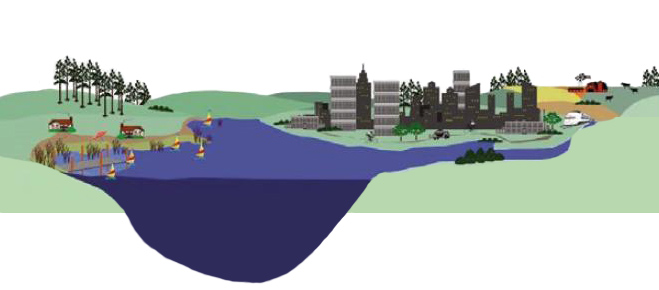Climate Change & Adaptations
Lake Superior
Climate change has been identified as one of the greatest threats facing the biodiversity of the Lake Superior Watershed. Climate change occurs at a pace at which humans must learn to adapt to. Many plant and animal species will be impacted by these changes and the research linked below on this page details some of these changes. This page points to some of the research concerning the future climate of Lake Superior based on climate models and historical data. The variations in the short term indicate that we can expect to have more frequent extreme weather events as the climate warms.
Projected Changes in Climate for the Great Lakes Basin
✓ Checkmarks indicate observed effects.

Credit: Linda Mortsch, Environment Canada
Airshed Effects:
- ✓ Increase in air temperatures
- ✓ Increase in precipitable water in warmer atmosphere
- Change in frequency and intensity of storms
Nearshore Effects:
- ✓ Increase in water temperature
- Increase in evaporation
Inlake Effects:
- ✓ Increase in water temperature
- Higher evaporative losses from lakes
- ✓ Less ice cover (shorter duration)
Watershed Effects:
- ✓ Warmer air temperatures
- ✓ More precipitation (decreases in key seasons)
- ✓ Less winter precipitation as snowfall and more rain
- ✓ Less snowpack
- ✓ More intense precipitation events
- Increase in evapotranspiration
More on Climate Change
- Climate-Ready City: City of Thunder Bay Climate Adaption Strategy
- Climate Change Education
- Lake Superior Climate Change Impacts and Adaptation
A Climate Change, Impacts and Adaptation Report - 2014
See the Executive Summary - Changes Expected in the Lake Superior Climate and Ecosystem - The Great Lakes Protection Act - Purpose & Importance
- The Great Lakes Protection Act - The Bill
- Ontario Climate Change Impacts and Adaptation
- A Changing Climate in Ontario - A Guide to introduce climate change adaptation and vulnerability
- Quarterly Climate Change Impacts and Outlook - Binational Committee
Drought Prediction
- NOAA Seasonal Climate Predictions for North America
- NOAA U.S. Seasonal Drought Outlook
- Canadian Climate Forecasts - Agriculture Canada
- Drought Predictions for the next 70 years based were completed by NASA based on historical tree ring data which shows the natural variation of the North American climate and on computer models which show changes which will likely happen as the planet warms
